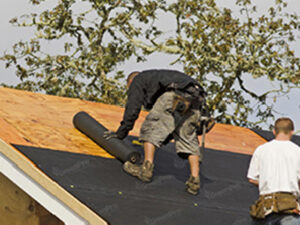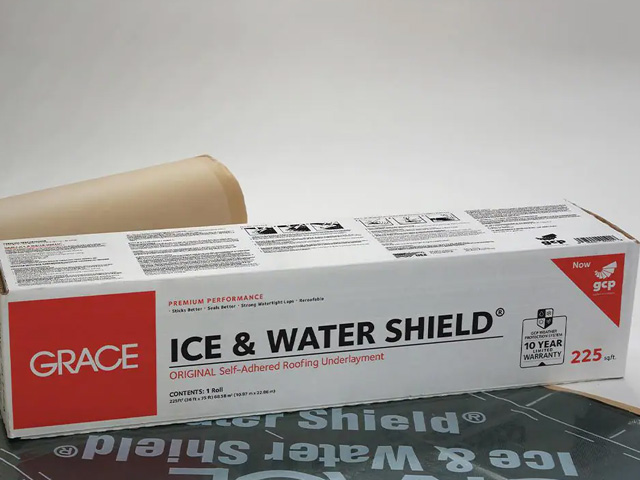Installing an ice and water shield can have its benefits and disadvantages. Here is a complete guide on ice and water shield pros and cons.
Let’s see whether it will be a beneficial effort or whether the cons outweigh the cons of this system and how to manage the cons to ensure you are getting the most out of your ice and water shield.
What is an Ice and Water Shield?
Ice and water shield is used as an underlayment for roofs. It allows you to easily cover your roof and insulate it from ice, water, and snow damage.
If you live in colder climates, protecting your roof from everlasting snow and melting ice is essential.
Ice can slowly damage your roof, causing seepage and slow growth of mold and other water-based microgrowths.
The shield comes in a layered material made with waterproof surfaces and resistant materials covering up your roofs and any crevices.
It forms a barrier to moisture seepage, causing the water to slide off, evaporate, and not seep into the building.
Advantages of Ice and water shield
Getting the water to evaporate in winter is not only a slow process but also a highly unlikely one.
This is why many ice and water shields try to capture the limited sunlight on their shiny surface and absorb the heat to speed up the process.
The sheet works as a smooth surface that eliminates the water buildup by first waiting for the snow to slide off.
If any stubborn snow is collected on top of the roof, it is trapped with shiny sun-connecting sheets that allow it to melt quickly rather than penetrating the roof or walls.
You can use the ice and water shield over any water entry areas in your house.
This includes places like gutters of your house, windows, roofs, ice dam formation on the roof, rake edges, eaves, skylights, attics, chimneys, and vents.
Wherever you see that the surface is not flat or slanted and there are chances of cracks, you can use this shield there.
This allows the building to be more secure and protected against such items. It is a simple barrier that will stick to the roof.
It will be a self-adhesive sheet with a sticky film at the back. You will see a simple peel-off sheet for easy application.
It will seal shingles or any nails or plastered wood pieces you have there. This is easy to do it yourself.
You can use the rubberized material to cover the nooks and crannies with a leaking potential. Without the ice and water shield, you must be wary of any windows or sun visors on the roof.
These areas can accumulate a lot of snow and cause damage over time.
Rust is another factor that can slowly cripple your roof if you are not effectively protecting against rust-related issues and sources in the presence of moisture.
An ice and water shield will give you holistic protection in these areas.
Pros
The shield also protects against wind-driven rain, ice dams, vulnerable areas of your roof, and leak problems in the ceilings.
In a nutshell, it will:
- The underlayment allows extensive protection against moisture leakage
- It will prevent any dripping from condensation and melting
- Allows quicker snow sliding
- Comes in an easy application set up with self-adhesive
- Can be cut to match your requirements
- Reduces any water damage to the construction
- Allows you to protect your house.
- You can self-apply it.
- No professional training is required.
- It is very diverse. It can be used at any point or area needing extra coverage.
- You can always add more layers wherever needed.
- Long-lasting and can be replaced every year or whenever necessary.
-
You can size to fit the layer on top of small crevices, nailings, and corner edges.
- Long-lasting adhesive that will not peel off itself.
Disadvantages of ice and water shield:
Your ice and water shield will need extra help if your house is designed with intricate details that make it easy for water to penetrate.
Also, if you live in particularly windy areas, you must protect your ice and water shield from upward water flows.
If you are in an area with a little to medium snowfall each year, you can try out a lighter version of weather protection in the form of PU paint.
A weathershield paint lets you cover your house fully in a sheet that enables coverage against the sun and water.
It forms a thin film over the top roofing, which you can use to withstand any water and ice accumulation.
In conjunction with the ice and water shield, this will give you great performance.

Cons
- The shield will need to be applied with patience.
- It may require extra help from the use of ice prevention hacks.
- It is time-consuming to cut out each piece according to your requirements.
- You must check if it is maintained or peeling off due to birds or other nesting.
- You will need a weathershield to extend the life of your roof
Is it easy to extend the life of your ice and water shield?
If your roofing has a lot of texture, silicon protection may be a good idea.
But, if you use shingles or other smaller pieces of roof tiles put together in a pattern with many crevices and ridges, this will be inefficient.
For a roof like this, you must use the ice and water shield sheets rather than any other low-cost alternative that may inflate your house repair bills.
It is safe to conclude that the pros of having ice and water shields outweigh the cons, and you should go for it.
How to protect your ice and water shield for your roof?
Roof underlayments can extend the performance of your ice and water shield.
It will allow the water to be stored above the sheet and will be water resistant to keep the water from penetrating below into the crevices or holes in the roof or shingles.
This will prevent amateur replacement of the shield before time. These give you an extra layer of benefits, so it must be worth the cost in addition to the ice and water shield.
The added protection will cover sun damage as well. They are an additional cost but will protect your ice and water shield and extend their benefits to a lot more.
Saving costs associated with an ice and water shield
Replacing windows is again an expensive issue. You can try hacks such as using silicon to cover your window vents and waterproofing them. This material creates a dam that pushes moisture outward.
However, silicone will not be efficient in melting the snow or pushing the ice downward.
Ensuring the natural factors favor your ice and water shield will help you extend its life and not require an early replacement.
Spraying salt mixtures on the ice and water shield can also help reduce snow buildup or ice formation. This will prevent any inward condensation or melting as well.
Verdict: Ice and Water Shield
It is a long-lasting solution for your roofing system. This will prevent damages long term. Even one sheet or covering up basic water exposure areas can save you hundreds of dollars annually.
Water damage can cause the walls to be damaged, which means paint problems, electrical issues, mold growth, and microorganisms overgrowths. You can prevent all of this with an ice and water shield.
Not having an ice and water shield will cause your building to take a serious effect from the damage. The water will seep into your ceilings and walls.
This can cause mold growth, paint chalking, and fall off. You may also notice droplets of water leaking from the roof during hot sunny times after the snow.
This is because instead of the snow or ice melting off, it is melting inside. You must curb this damage to protect your home from such mess through weather damage.
You can save a lot of effort, time, and money later if you invest some energy in covering your roof with a shield.
This allows you to monitor the snow situation and curb any seepage timely easily. You can also save yourself from recurring paint jobs, swollen, moldy wood ceilings, and other losses from indoor moisture leaks.

Arthur is a skilled roof worker with over 10 years of experience in the industry. He started his career as an apprentice and worked his way up to become a foreman.
When he’s not working on roofs, John enjoys with his family or writing posts. He is also a passionate cyclist.

